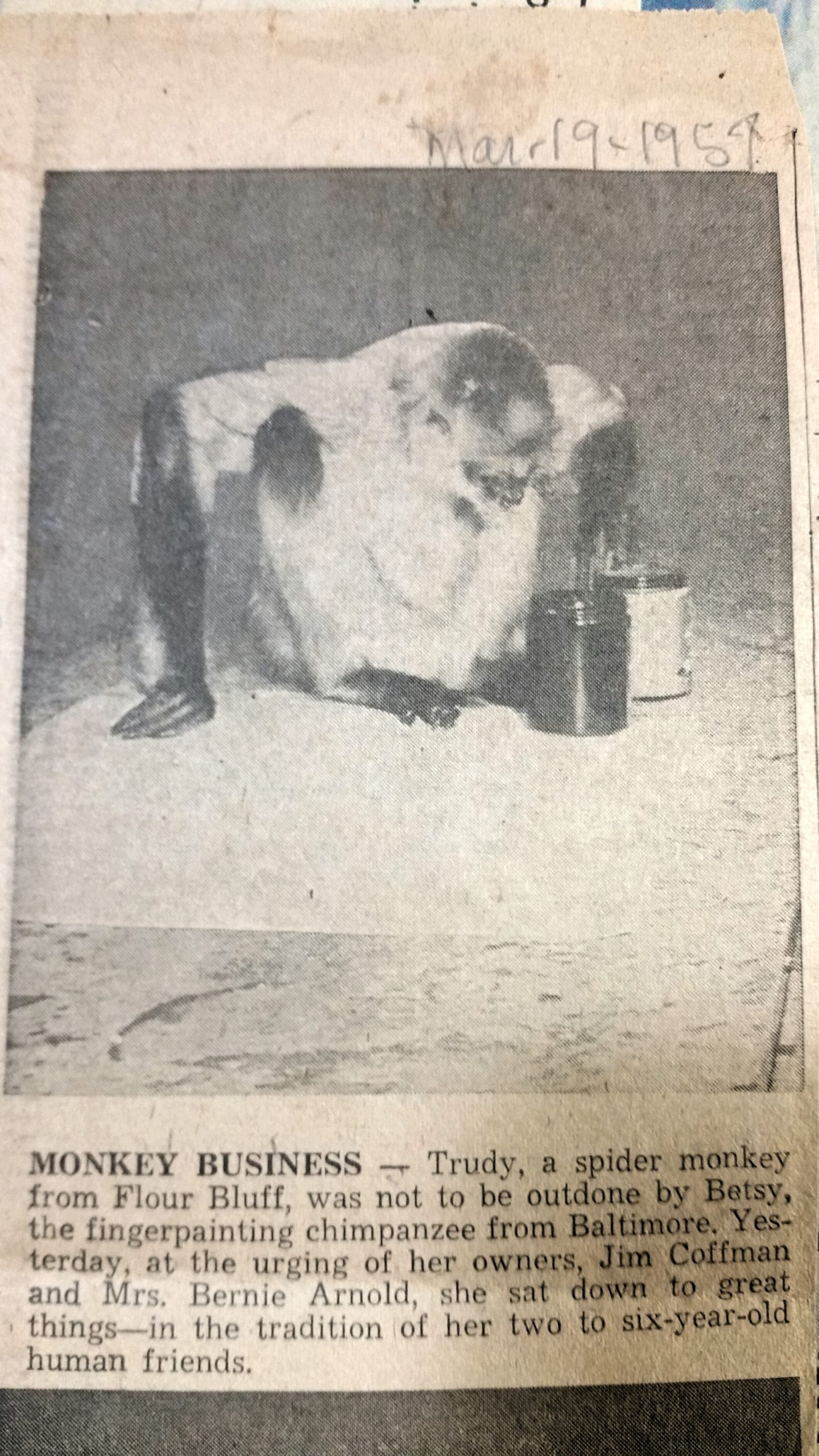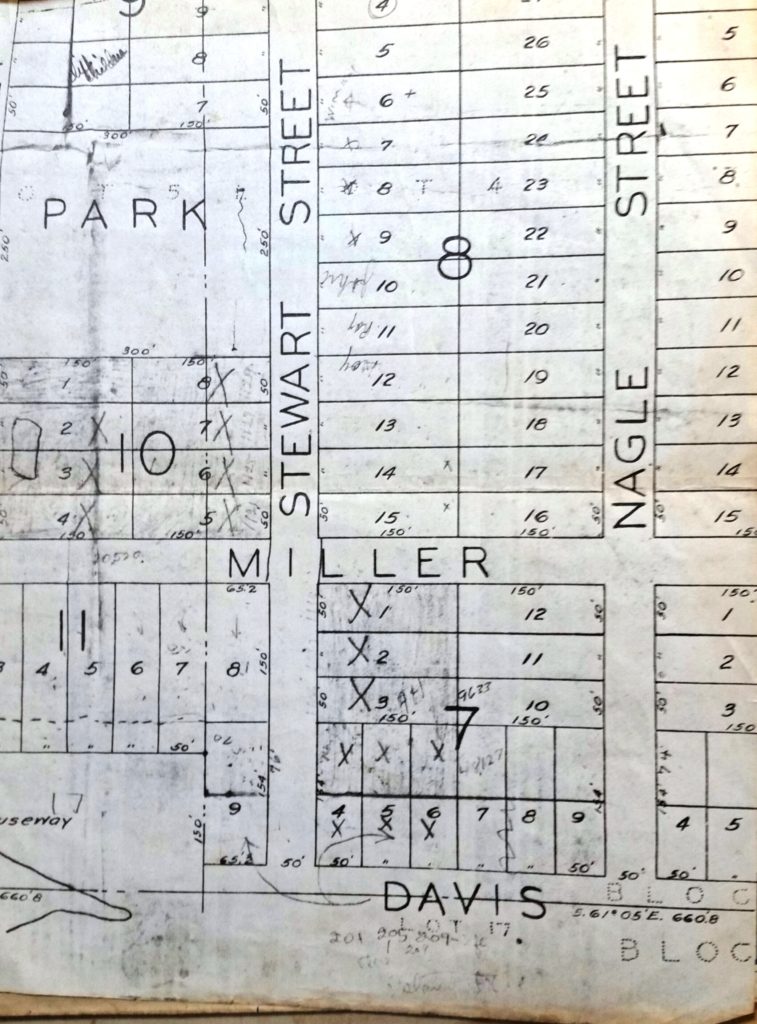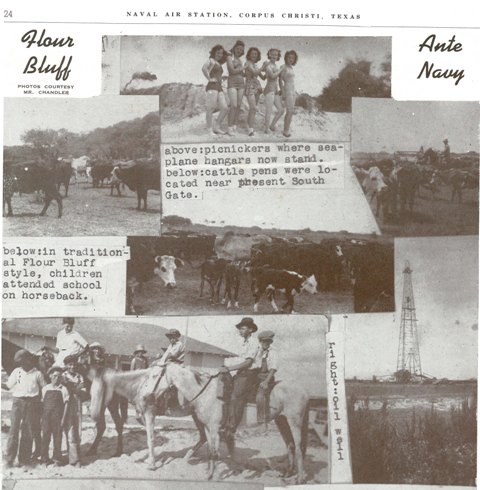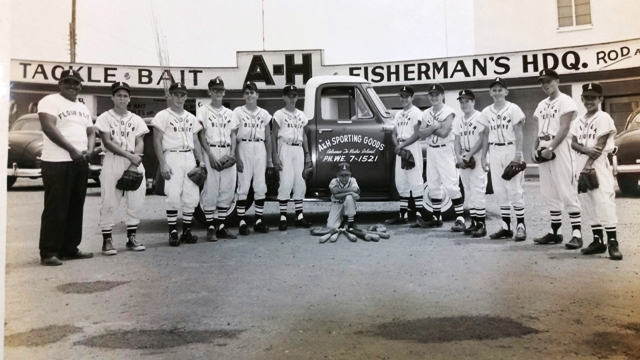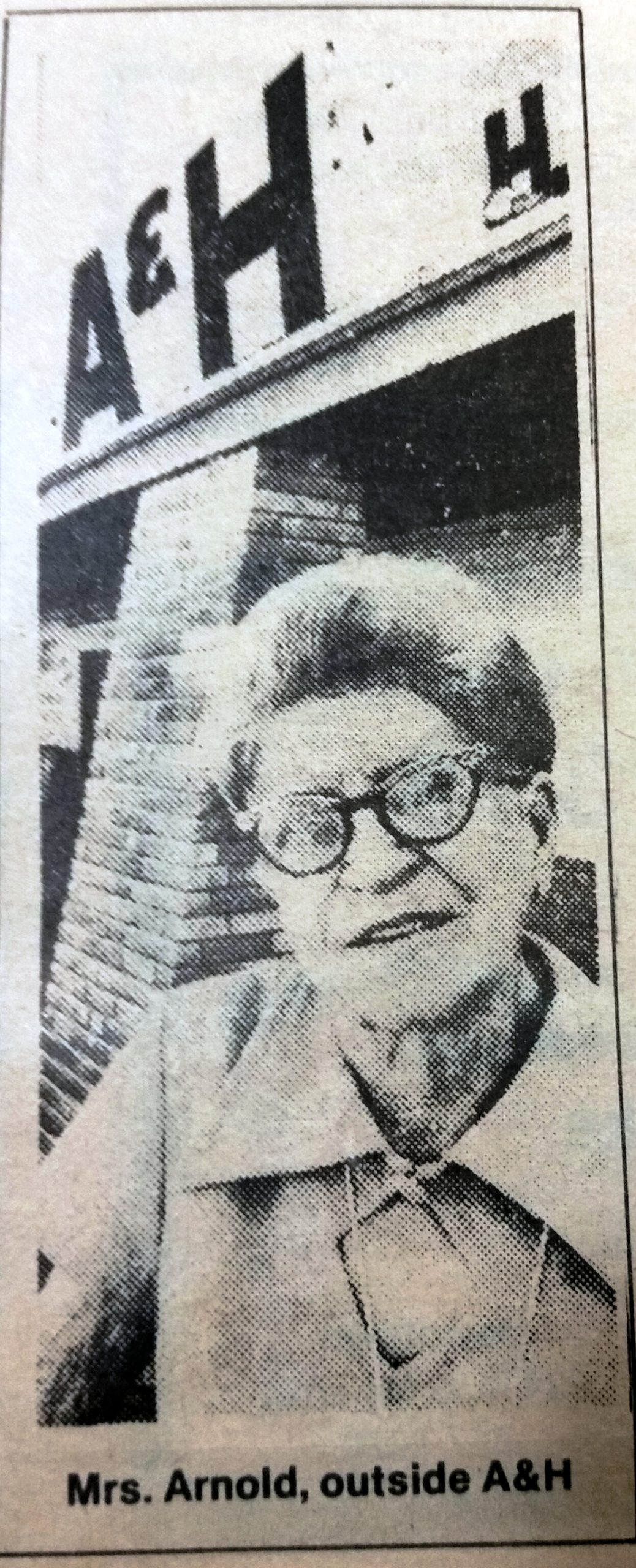[spacer height=”20px”]
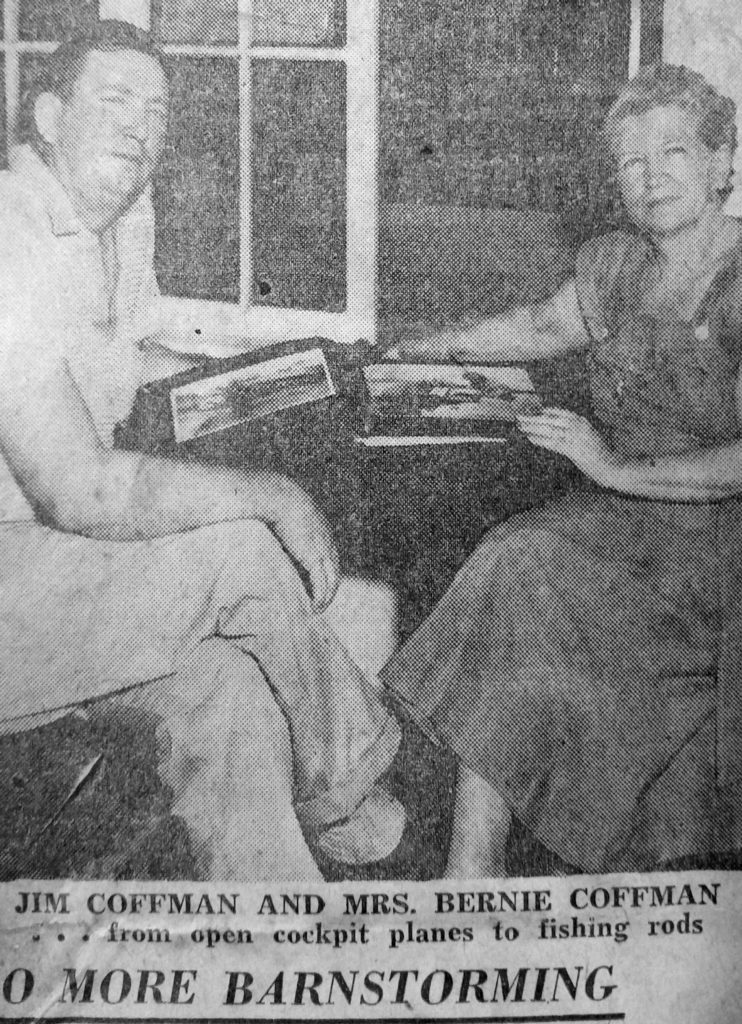
Bernie (Coffman) Arnold and son, Jim Coffman, at A&H Sporting Goods in Flour Bluff, ca. 1951 (Photo courtesy of family of Bernie Arnold)
[spacer height=”20px”]
Bernie (Coffman) Arnold had barnstormed her way through life, doing that which most women born in 1899 would never imagine doing. She had the heart of a risk-taker, so moving to Corpus Christi with only $225 in her pocket wasn’t out of character for her. Bernie perhaps knew a little about the area from what her brother, William T. Harlan, had told her. He was stationed at NASCC during WWII. Still, when her friend and fellow pilot, O. L. Holden, asked her to go into the bait and tackle business with him, she simply agreed and moved to Corpus Christi in 1946. She and Holden opened A&H Bait and Tackle on N. Water Street. It wasn’t long before Bernie bought land along Davis Drive (now South Padre Island Drive) and Stewart Drive (a paper street that became Laguna Shores Road) and prepared to open a second A&H in Flour Bluff. Bernie started a different kind of barnstorming in Flour Bluff.
[spacer height=”20px”]
[spacer height=”20px”]
In the years when Bernie was carving out her place in the world, Flour Bluff was doing the same. The Encinal Peninsula that jutted out into Corpus Christi Bay had a way of attracting people like Bernie who saw its potential and went about laying a foundation for a town that would never come to be. Flour Bluff Point, where NAS CC sits today, was identified by the 40-foot dunes that graced the landscape. It was a place that many visited for duck hunting, fishing, gathering of salt, and even for hiding from the enemy during the Civil War. Actual settlement of the area wouldn’t take place until after 1890.
Timeline of development of Flour Bluff:
- 1890 Ropes Boom brings families to Flour Bluff via Ward Island Road. (TAMUCC sits on Ward Island today.)
- 1892 George Hugo Ritter builds the first school. (See picture below. George Hugo Ritter stands in the doorway behind the students.)
[spacer height=”20px”]
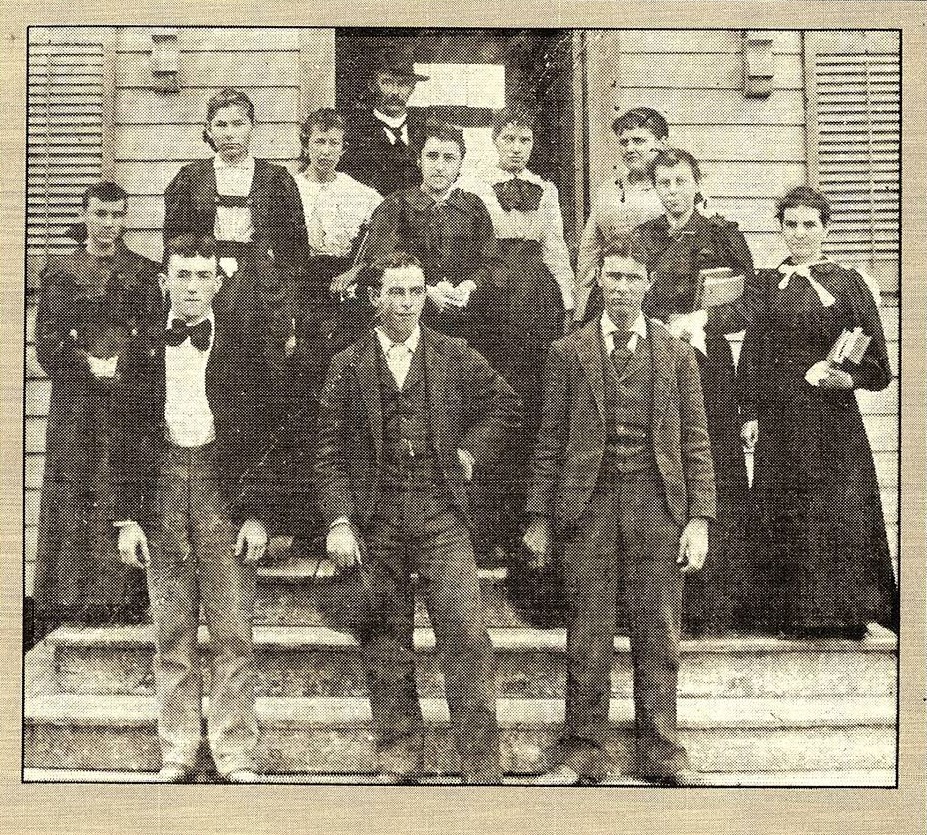
George Hugo Ritter stands in the doorway of the school where early Flour Bluff students attended both church and school. (Photo courtesy of Don Crofton)
[spacer height=”20px”]
- 1893 First post office opens.
- 1898 Ropes attempts to dig a pass across Mustang Island to the Gulf of Mexico for shipping.
- 1900 Truck farmers and ranchers dominate the peninsula. Ritters open a dairy. Grapes, onions, pineapples, cantaloupe, and even sea cotton are grown.
- 1905 Herman and Edgar Roscher build Mud Bridge over the Oso. Cline attracts fishermen and water fowl hunters to the area.
- 1916 Flour Bluff families erect new school building.
- 1927 Don Patricio Causeway is built from Hugo Ritter’s lagoon beach across the Laguna Madre to Pat Dunn’s ranch house at Packery Channel. Sam Robertson, a military engineer who bought the Dunn ranch, built the wooden causeway on pilings. It opened on July 4, 1927, and cars could pass slowly across the lagoon for $3 a carload. For the first time, the mainland was joined to the island and a steady stream of traffic crossed the causeway, 1,800 cars the first month and 2,500 the second. Flour Bluff and the island start to see growth – and lots of fishermen.
- 1927 Ritters open a bait stand on the new causeway.
[spacer height=”20px”]
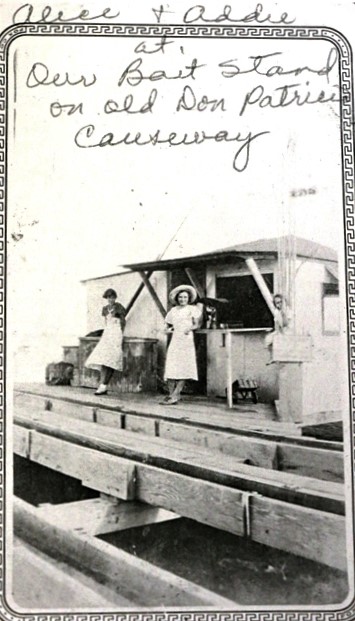
Ritter girls work the family bait stand on the first causeway, ca. 1935 (Photo courtesy of Kathy Orrell)
[spacer height=”20px”]
- 1927 H.H. Friar, local realtor, builds Remington Lodge at Flour Bluff Point.
- 1929 The Great Depression hits, but Flour Bluff survives. Subdivisions are built. Hunting and fishing draw people into the little community, which helps locals make a living.
- 1933 The worst of the 1933 storms hits September 5 and smashes the Don Patricio Causeway. The salt water settles over the farm land making it too salty to grow crops.
- 1935 Oil is discovered in the central area of Flour Bluff. Oil camps bring more people and more businesses to the peninsula.
- 1938 Flour Bluff School No. 22 is built.
[spacer height=”20px”]
[spacer height=”20px”]
- 1940 Some of the original settlers of Flour Bluff are declared “squatters” and forced to move off Flour Bluff Point. The giant dunes are leveled by the U.S. Government, and NAS is built. Flour Bluff population grows (roughly 100 persons per year), bringing more businesses. Water line built by private company for NAS. New bridge built across Oso at current location. Tex-Mex RR laid through FB and across the Oso.
- 1945 War ends, and Flour Bluff growth continues.
- 1946 Flour Bluff Schools become independent school district under Sup’t. E. J. Wranosky.
- 1947 Flour Bluff property owners form a Water and Sanitation District.
- 1950 Nueces County Water Control and Improvement District No. 2 is created. John Orville Nicholson, owner of Nicholson grocery, is elected president. $700,000 water bond passes. County constable’s office opens because of all the “speeding and carousing out there,” according to Sheriff John Harney. Talks of incorporating the Flour Bluff community and making it a town begin.
- 1951 Water lines laid, and meters installed by June. Residents pay out-of-city rates for a reliable water source. Access to reliable water moves to top of Flour Bluff’s list of priorities. A&H Sporting Goods, owned by Bernie Arnold and Jim Coffman, opens July 4, 1951.
[spacer height=”20px”]
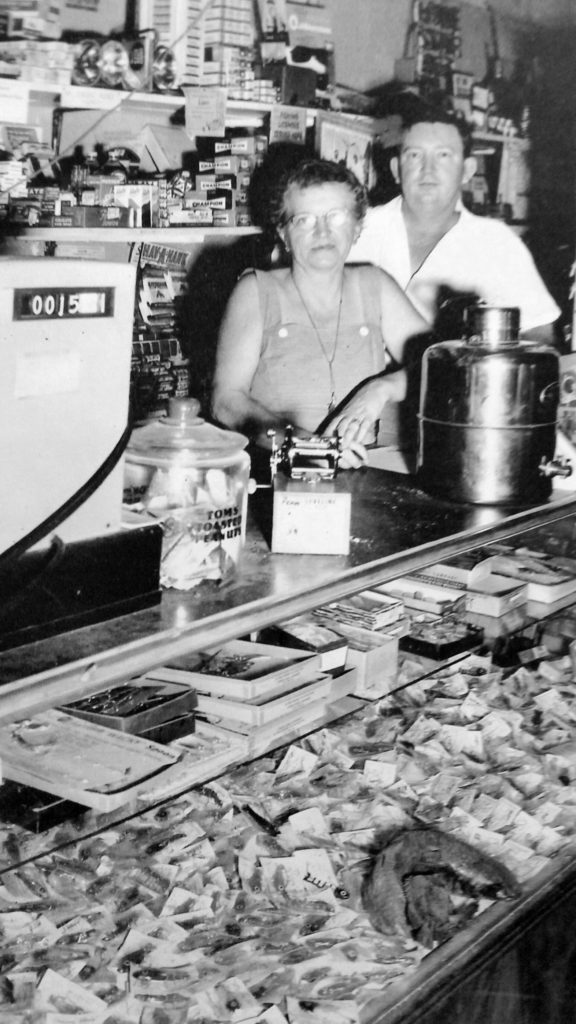
Bernie Arnold and son Jim Coffman at the new location of A & H Sporting Goods in Flour Bluff (Photo from Bernie Arnold collection)
[spacer height=”20px”]
Bernie’s arrival in Flour Bluff was not by chance. She had a vision of what her sporting goods store could be if it sat on the right side of the road leading to the island. Each year, as the tourists came through Flour Bluff by the thousands, Bernie and Jim worked to give them what they needed. In 1952, she added plugs, ice, and gas to her inventory. She lived above the store and was open 24 hours a day. One night in 1952, Bernie heard someone in the store and went downstairs to see what they wanted to buy. There she found three hoodlums who attempted to rob the store. Bernie picked up a hammer and started swinging at them. The boys ran like the wind but were caught by police on Kostoryz, according to a Caller-Times article.
In 1953, she added beach and camping gear. The island was no longer just a sportsman’s paradise. People came from near and far to camp on the beach. In 1954, Bernie offered free repair service (performed by Jim) and Coleman lanterns. Business was so good in 1954, that Bernie sold the Water Street store and focused on the Flour Bluff business. As is the case today, many parts of the island were not accessible in ordinary vehicles, so Bernie began renting Jeeps in 1955. She also sold plumbing, electrical, and general household goods added to the locals. It was this year that she and Jim built the boat barns so that people would have a place near the Laguna Madre to store their boats, and 1955 was also the year that Bernie flew a plane for the last time. By 1956, this mother-son team added outboard service, built an ice house, and sold beachwear and Levi’s. Bernie’s business was booming. She could have chosen to simply run her sporting goods store and turn in each night, but Bernie turned to building the community instead.
[spacer height=”20px”]
[spacer height=”20px”]
Bernie set to work improving the quality of life for everyone in the Flour Bluff community. It might even be said that Bernie was building a town. She helped start the Padre Island-Flour Bluff Business Association and served as treasurer for five years in the 1950s. She helped start and served as secretary-treasurer for the Nueces County Rural Fire Prevention District No. 2 (Flour Bluff Volunteer Fire Department started unofficially in 1952, officially in 1958.) She helped with the 110 miles Padre Island Walkathon in 1954, an incredible feat for the participants but a great way to draw in more than the average beach-goer. Bernie’s love of sports of all kinds prompted her to sponsor the first baseball team and a boxing club. She even had her own arena in 1955. It sat on what is now SPID. The first baseball field was where Whataburger is today. Bernie sponsored the “Tall Tales of Texas Fishing” story contest and even published first newspaper and first phone book in 1960s. Yes, Flour Bluff was growing into a bonafide town, or so it seemed.
In 1953, Bernie, Jim, and several other Flour Bluff business owners and concerned citizens, decided it was time to incorporate. However, it was not something everyone wanted. The idea went to the Flour Bluff voters and failed 209-120. At that time, the City of Corpus Christi officials had no plans to annex Flour Bluff, according to William Anderson, then City Planning Engineer. The matter went to the voters again in 1956. Of the 407 registered voters in Flour Bluff, 288 went to the polls and dashed the hopes of township once again, this time 156-124. This proposal was for a four-square-mile area bounded by Graham Road, the Tex-Mex RR on Flour Bluff Drive, NAS, and the Laguna Madre.
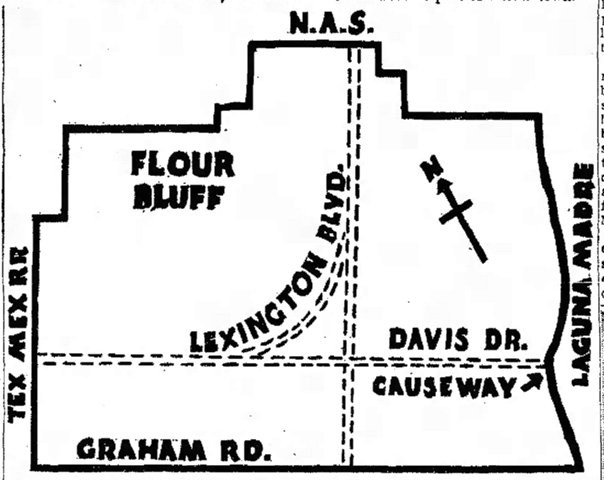
Map for city limits of Flour Bluff, the little town that almost was (Photo from Bernie Arnold collection)
In 1958, Flour Bluff tried incorporation again, this time for the area between NAS, the Oso, Waldron Field (including Tropic Isles), and the Laguna Madre. Many opposing the idea did not like municipal control of any kind. Some feared that Corpus Christi mayor, Farrell Smith, would make good on his threat to cut off the water if the Flour Bluff residents voted to become a town. On the other hand, some residents thought that Corpus Christi would do a better job providing much-desired services. Their fears won out, and the move to incorporate failed again with a vote of 334 to 231. The mayor of Corpus Christi claimed that annexation of Flour Bluff was not being considered by the city, but that would not remain true for long.
_________________________________________________________________
The editor welcomes all corrections or additions to the stories to assist in creating a clearer picture of the past.
Please contact the editor at shirley.thornton3@sbcglobal.net to submit a story about the early days of Flour Bluff.
